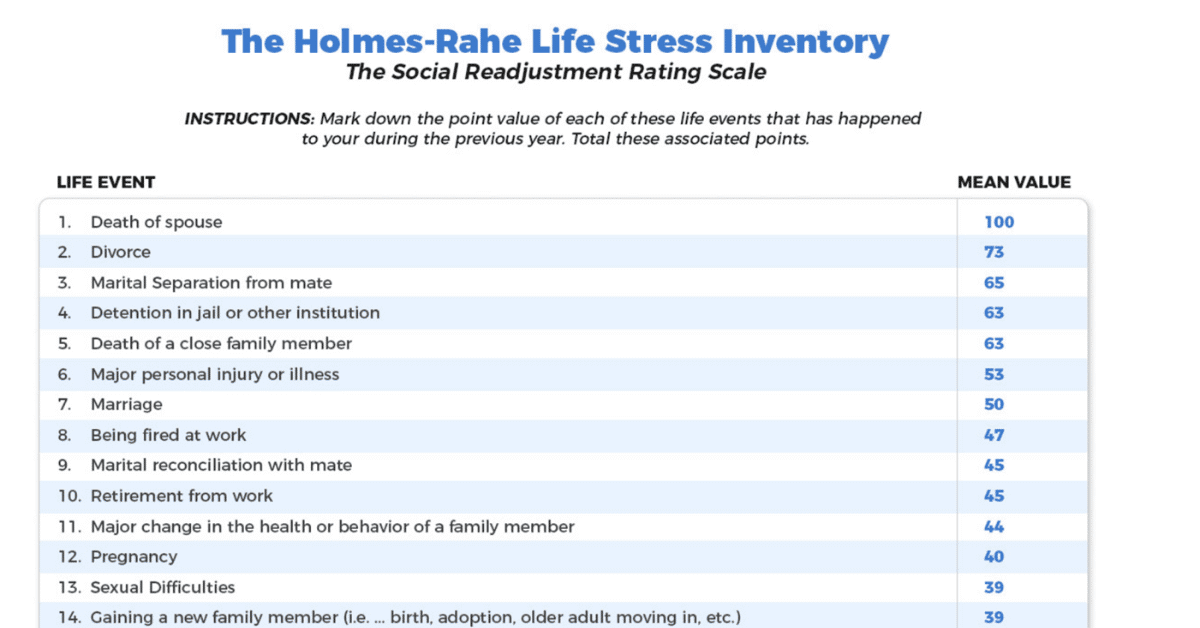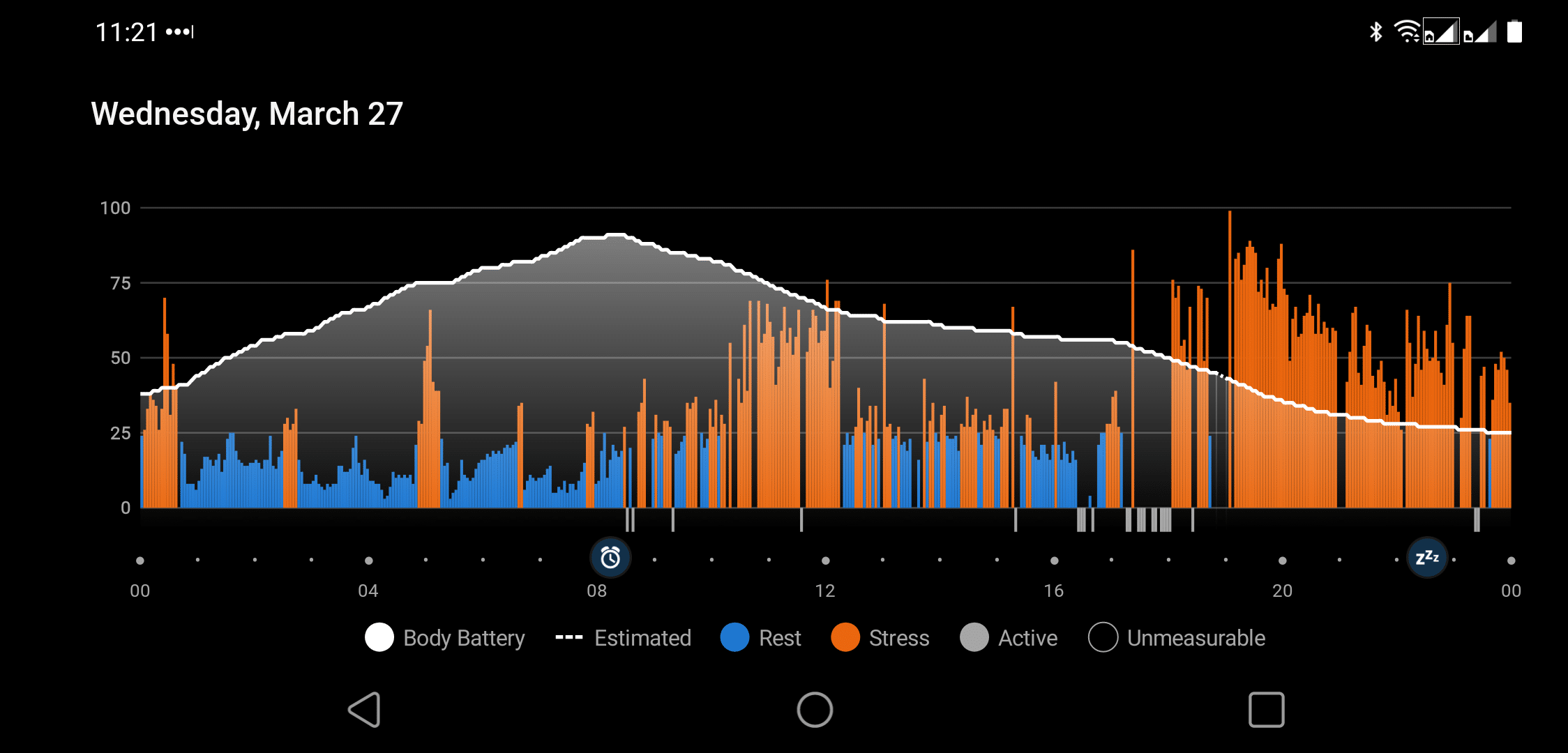In today’s world, stress is a prevalent health concern, with significant impacts on both physical and mental health. The Holmes and Rahe Stress Scale emerges as a pivotal tool for gauging the risk of stress-induced illness. It offers individuals a method to evaluate their stress levels based on life events 1.
What is the Holmes and Rahe Stress Scale?
The Holmes and Rahe Stress Scale (aka the Social Readjustment Rating scale) is a tool for measuring stress levels based on life events. It assigns scores to 43 different life changes to quantify stress risk, aiding in predicting health outcomes. It’s used for personal insight, academic study, and mental health assessment.
This blog is part of a series on “stress assessments.” The next blog is about the Beck Anxiety Inventory.
Key Insights on the Holmes and Rahe Stress Scale
- The Holmes and Rahe Stress Scale quantifies stress by assigning life change units (LCUs) to 43 specific life events.
- This scale helps individuals assess their risk of stress-related health issues by totaling the LCUs from experienced events.
- Developed in 1967, it’s based on the premise that positive and negative life changes can contribute to stress.
- The scale has been validated through empirical research, showing a statistical correlation between high scores and subsequent health problems.
- Variants of the original scale exist for different demographic groups, including children, to better reflect diverse life experiences.
- Regular self-assessment using this scale can be a proactive part of managing one’s mental health and well-being.
Understanding the Stress Scale
The Holmes and Rahe Stress Scale, born in 1967, illuminates how life’s rollercoasters affect us. It lists 43 life events that could sky-high our stress levels, from tying the knot to getting the boot at work. Each event adds points to your stress tally.
This scale isn’t just about adding numbers. It’s a mirror showing how these life changes might mess with our health. Think of it as a stress-o-meter. The higher your score, the more you might need to chill out or seek support.
The Role of Empirical Evidence
Science backs up the Holmes and Rahe scale big time. Studies have shown a clear link between high scores and health hiccups down the road. It’s like predicting rain with dark clouds; this scale predicts health storms based on stress levels.
Researchers have analyzed data, finding that people with sky-high scores often face health challenges soon after. It’s not magic, just science, proving that stress can lead to breakdowns if left unchecked.
This evidence isn’t just dust gathering on old textbooks; it’s used today by professionals helping people navigate tough times. By understanding the impact of stressful life events, they tailor support to keep us ticking along nicely.
Assessing Your Stress Levels
Gauging stress with the Holmes and Rahe scale is easier than pie baking. You check off life events you’ve experienced recently, then tally up your score. High scores wave red flags that it might be time to stop or seek help.
This isn’t about scaring you into living in a bubble; it’s about awareness. Knowing your score helps you understand when to pump the brakes on life’s fast lane or when to reach out for support from friends or professionals.
| Life Event | Impact Score (LCUs) |
|---|---|
| Death of a spouse | 100 |
| Divorce | 73 |
| Marital separation | 65 |
| Jail term | 63 |
| Death of a close family member | 63 |
| Personal injury or illness | 53 |
| Marriage | 50 |
Assessment is step one in taking control of your well-being journey—like knowing you’re lost before asking for directions. Armed with knowledge about your stress levels, you’re better equipped to tackle what comes next head-on.
Addressing 1970’s Scale in Today’s Context
The world has changed a lot since 1970, but guess what? Even if bell-bottoms don’t, the Holmes and Rahe scale still holds up pretty well today. Sure, we’re now dealing with modern stresses like social media overload or remote work woes that weren’t around back then.
The beauty of this scale lies in its simplicity and adaptability over time. Even though some items may seem dated (like receiving a telegram), the essence captures today’s pressures too—because at their core, many stresses remain constant across generations.
Incorporating current lifestyle challenges into assessments ensures this tool remains relevant for anyone looking to gauge their stress levels accurately—proving good science ages well, much like fine wine or classic rock tunes.
The Importance of Regular Self-Assessment
Checking your stress levels shouldn’t be a once-in-a-blue-moon activity; it should be more regular than binge-watching your favorite series. Regular self-assessments help catch sneaky stress before it turns into full-blown chaos mode.
This practice isn’t just about avoiding breakdowns and maximizing well-being and happiness daily. When we monitor our stress levels through tools like the Holmes and Rahe scale, we become masters of our ships, navigating stormy seas more confidently and with less panic.

Making self-assessment part of your routine is like having an internal weather station: always ready to forecast emotional turbulence so you can take necessary precautions—because who enjoys being caught in a storm without an umbrella?
Personal Thoughts
In my quest to manage the chronic stress that life threw my way, I discovered the Holmes and Rahe Stress Scale. It offered me a scientific approach to measure and understand the impact of various life events on my stress levels.
Using this scale as part of my broader strategy for managing stress has been enlightening. It helped me identify specific stressors and their potential effects on my health, guiding me toward more effective coping mechanisms. Sharing these insights is part of my commitment to helping others find their path to stress management.
Don’t want to take the test online? Then get the downloadable version.
Take the Holmes and Rahe Stress Scale Test here:
INSTRUCTIONS: Select the life events that have happened to you during the previous year.
Please leave your email below to receive the results in your inbox. I’ll also send you my free eBook Beyond Deep Breaths, which contains ten lesser-known but very practical stress-coping skills to get you started.
Frequently Asked Questions
How does the Holmes and Rahe Stress Scale measure stress?
The Holmes and Rahe Stress Scale quantifies stress by assigning “life change units” (LCUs) to 43 specified life events. Each event has a different weight based on its potential stress impact, and the total score indicates the chance of health breakdown within the next two years.
Can the Holmes and Rahe Stress Scale predict health outcomes?
Thomas Holmes and Richard Rahe designed the scale to statistically correlate total scores with the likelihood of experiencing a health breakdown. High scores suggest a greater risk, predicting potential health issues related to stress within a short period following significant life changes.
Is there a modified version of the Holmes and Rahe Stress Scale?
Indeed, there are modified versions of the original scale tailored to different demographics, such as for non-adults or specific professional groups. These adaptations consider varying life circumstances and stressors to provide more relevant evaluations for distinct populations.
How do cultural differences impact the scale’s effectiveness?
Cultural differences can influence how individuals perceive and react to various stressors, potentially affecting the scale’s effectiveness across diverse populations. While it offers a general framework for assessing stress risk, its applicability may vary, underscoring the importance of cultural sensitivity in psychological assessments.





